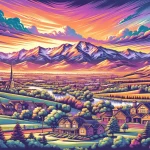Romeo, Colorado, is a small unincorporated community in Conejos County, with just 404 residents as of the 2020 census. It is just south of La Jara and north of Antonito. Despite its modest size, Romeo has a rich history and a unique cultural landscape that sets it apart from other rural communities in the region.
In This Article
TL;DR
- Romeo is a small, unincorporated community in Conejos County, Colorado, with 404 residents.
- The small town has a rich agricultural history, with potatoes being a major crop in the early 20th century.
- Romeo is home to a vibrant Hispanic community, with many residents tracing their roots back to early Spanish settlers.
Geography and Climate of Romeo, Colorado
Romeo is situated in the San Luis Valley, a high-altitude region in south-central Colorado known for its stunning natural beauty and diverse ecosystems. The small town sits at an elevation of 7,664 feet above sea level, surrounded by the majestic peaks of the San Juan Mountains to the west and the Sangre de Cristo Mountains to the east.
Romeo’s climate is characterized by cool summers and cold winters, with average temperatures ranging from the mid-30s in January to the mid-70s in July. The region receives an average of 7 inches of precipitation annually, most of it falling as snow during the winter months.
Historical Context and Development
The area now known as Romeo was first settled by Spanish explorers and farmers in the late 18th century. They were drawn to the region’s fertile soil and abundant water resources, some of the best in the state. The town was founded in the early 1900s and named after the famous Shakespearean character of the same name.
Throughout the early 20th century, Romeo thrived as an agricultural community. Potatoes were the primary crop grown in the area. The town’s population peaked in the 1940s, with over 1,000 residents calling Romeo home.
Economic Landscape
Today, agriculture remains a significant part of Romeo’s economy. Many residents work in the fields or related industries such as food processing and distribution. The town also has a few small businesses, including a general store, a post office, and a community center.
Romeo faces many of the same economic challenges as other rural communities in Colorado, including limited job opportunities and an aging population. However, the town’s strong sense of family and community and rich cultural heritage have helped it weather these challenges and maintain a vibrant local economy.
Cultural and Community Life
One of the most notable aspects of life in Romeo is the town’s strong Hispanic heritage. Many residents trace their roots back to the early Spanish settlers who first inhabited the region. This cultural influence is evident in the town’s annual festivals and events, such as the San Luis Valley Potato Festival, which celebrates the area’s agricultural history and the contributions of Hispanic farmers.
The town is also home to a number of community organizations and clubs, including a 4-H club and a senior citizens group. These groups play an essential role in fostering a sense of community and providing opportunities for residents to come together and celebrate their shared history and culture.
Education and Local Institutions
Despite its small size, Romeo is home to several important local institutions, including a public library and a community center. The South Conejos School District serves the town and operates an elementary school and a high school in nearby Antonito.
In addition to formal education, Romeo also offers a variety of community programs and initiatives to promote lifelong learning and personal growth. These include adult education classes, youth sports leagues, and cultural enrichment programs.
Outdoor Activities and Natural Attractions
One of the biggest draws of living in Romeo is the town’s proximity to a wide range of outdoor recreational opportunities. The nearby San Juan Mountains offer endless possibilities for hiking, camping, fishing, and wildlife viewing, while the Rio Grande River provides opportunities for rafting and kayaking.
The town is also home to several parks and open spaces, including Romeo Park and the Conejos River Trail. These areas provide residents with opportunities to enjoy the great outdoors and connect with nature without having to travel far from home.
Infrastructure and Transportation
Romeo’s infrastructure and transportation options are limited as a small rural community compared to larger Colorado cities. The town is served by a network of county roads, with the nearest major highway being U.S. Route 285, which runs north-south through the San Luis Valley.
Despite these limitations, Romeo has made significant investments in its local infrastructure in recent years, including upgrades to its water and sewer systems and improvements to its parks and public spaces. The town is also exploring opportunities to expand its transportation options, including the possibility of establishing a regional transit system to connect Romeo with other communities in the San Luis Valley.
FAQ
What is the population of Romeo, Colorado?
As of the 2020 census, the population of Romeo, Colorado, is 404 residents.
Can you describe the climate and best times to visit Romeo, Colorado?
Romeo has a cool, high-altitude climate, with average temperatures ranging from the mid-30s in January to the mid-70s in July. The best time to visit is during the summer when the weather is warm and dry, and the town’s many outdoor recreational opportunities are at their peak.
What are the major industries that drive Romeo, Colorado’s economy?
Agriculture remains a significant part of Romeo’s economy, with many residents working in the fields or related industries such as food processing and distribution. The town also has a few small businesses, including a general store, a post office, and a community center.
What cultural events or festivals are unique to Romeo, Colorado?
One of Romeo’s most notable cultural events is the annual San Luis Valley Potato Festival, which celebrates the area’s agricultural history and the contributions of Hispanic farmers. The town also hosts a number of other festivals and events throughout the year, showcasing its rich cultural heritage and community spirit.
What outdoor activities are available in Romeo, Colorado?
Romeo is surrounded by a wide range of outdoor recreational opportunities, including hiking, camping, fishing, and wildlife viewing in the nearby San Juan Mountains, as well as rafting and kayaking on the Rio Grande River. The town is also home to several parks and open spaces, providing residents with easy access to nature and outdoor activities.






